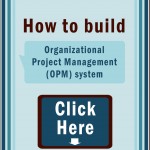
In a recent workshop on organizational project management (OPM) a participant asked me what is the link of OPM to QMS, Quality Management System?
Before we can answer, let us briefly explain what is a process and how processes fit into our lives and our organizations.
Process(es)
A process is usually about producing something – an output. To produce this output we need something to start with (input), we need tools, and often there is (are) technique(s) to use to produce this output. For examples:
- To cook a meal, there is a process: we need ingredients and cooking utensils, there is a technique to cook, which require knowledge, and there is an output, a cooked meal.
- To write a book is a process that requires knowledge (input), tools – a PC or typewriter, fingers and brains 🙂 to produce the output.
The same applies in organizations whether we are processing a vacation request, checking an expense statement, working on a project (more than one process), or developing a strategic plan. Of course some processes could be very simple while others are quite comprehensive and substantial, which may result in breaking down a major process into sub-processes.
Organizational Processes
Organizational work consists of numerous processes at all levels. We like to group the organizational processes into three principal categories:
- Corporate Processes: these would be the high level corporate processes including strategic planning, governance, succession planning, and other executive level processes.
- Operational (Functional – Technical) Processes: These would be the operational processes carried out across the organizational functions, such as human resource, marketing, finance, among others. We typically refer to these also as business processes, or technical processes if a department is technically oriented like engineering or technology.
- Project Management Processes: these would be the numerous processes required to manage a project, a program, or even the portfolio of projects in the organization.
The Links
How are these linked?
It depends!
An organization could have a strategic business excellence program that encompass all of the organizational processes whether they are strategic, operational, or project management. This might be the ideal scenario.
Other organizations, probably the most common form, is that such organizations have business (operational) processes under the heading of QMS = Quality Management System. Further, if this organization adopt a project management culture, they could have an independent system, an Organizational Project Management System.
The Links Expanded
Back to the question in class. I think we already indirectly explained the link but let us expand on the concept. In the class, we started to draw the link, which resulted in the following image.
Although, I do not like the box analogy but it serves the purpose of showing that organizational processes are three-dimensional with corporate processes (primarily Governance) serving as the oversight for all other processes.
In the class was my good friend Nah Wee Yang, a director of Knowledge Method in Singapore, who was hosting the workshop for their clients. Wee Yang like to draw and he produced the following from the above image and explanation.
Wee Yang added into the picture his artistic touch but also added organization culture as a dead weight that could tie an organization down. Well – this is justifiable since it is often the case where organizational culture could be a hindrance.
Although we could not match Wee Yang artistic skills, we reproduced the image but with a balanced perspective.
I think what we add is a clear – it is a call to action – it is a challenge to organizations. The challenge is obviously related to organizational culture and it is whether organizations have enough maturity to let their organizational culture lift them up toward excellence, or will their culture hold them down into situation without processes or bureaucracy and other ineffective practices?




Nicely written. And I like the perspective of organization culture can be seen as an up-lifting force, apart from being a hindrance. Thanks for sharing.
Thanks Wee Yang – i guess this is a proof that we should meet more often since it is nice how an idea evolved in collaboration! February or March … will meet again 🙂